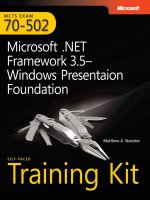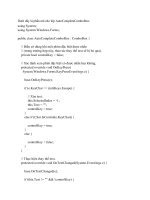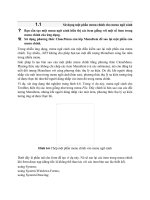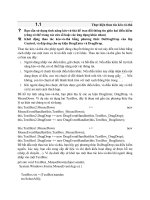designing and developing windows applications using microsoft.net framework 4
Bạn đang xem bản rút gọn của tài liệu. Xem và tải ngay bản đầy đủ của tài liệu tại đây (16.5 MB, 337 trang )
MCPD 70-518
Exam Ref:
Designing and Developing Windows
®
Applications Using Microsoft
®
.NET
Framework 4
Tony Northrup
Matthew A. Stoecker
Published with the authorization of Microsoft Corporation by:
O’Reilly Media, Inc.
1005 Gravenstein Highway North
Sebastopol, California 95472
Copyright © 2011 by Tony Northrup and Matthew Stoecker
All rights reserved. No part of the contents of this book may be reproduced
or transmitted in any form or by any means without the written permission of
the publisher.
ISBN: 978-0-7356-5723-6
1 2 3 4 5 6 7 8 9 QG 6 5 4 3 2 1
Printed and bound in the United States of America.
Microsoft Press books are available through booksellers and distributors
worldwide. If you need support related to this book, email Microsoft Press
Book Support at Please tell us what you think of
this book at
Microsoft and the trademarks listed at />en/us/IntellectualProperty/Trademarks/EN-US.aspx are trademarks of the
Microsoft group of companies. All other marks are property of their respec-
tive owners.
The example companies, organizations, products, domain names, email ad-
dresses, logos, people, places, and events depicted herein are ctitious. No
association with any real company, organization, product, domain name,
email address, logo, person, place, or event is intended or should be inferred.
This book expresses the author’s views and opinions. The information con-
tained in this book is provided without any express, statutory, or implied
warranties. Neither the authors, O’Reilly Media, Inc., Microsoft Corporation,
nor its resellers, or distributors will be held liable for any damages caused or
alleged to be caused either directly or indirectly by this book.
Acquisitions and Developmental Editor: Ken Jones
Production Editor: Holly Bauer
Editorial Production: S4Carlisle Publishing Services
Technical Reviewer: Bill Chapman
Copyeditor: Susan McClung
Indexer: Potomac Indexing, LLC
Cover Composition: Karen Montgomery
Illustrator: S4Carlisle Publishing Services
Contents at a Glance
Introduction xv
Preparing for the Exam xviii
CHAPTER 1 Designing the Layers of a Solution 1
CHAPTER 2 Designing the Presentation Layer 89
CHAPTER 3 Designing the Data Access Layer 173
CHAPTER 4 Planning a Solution Deployment 225
CHAPTER 5 Designing for Stability and Maintenance 265
Index 303
v
What do you think of this book? We want to hear from you!
Microsoft is interested in hearing your feedback so we can continually improve our
books and learning resources for you. To participate in a brief online survey, please visit:
www.microsoft.com/learning/booksurvey/
Contents
Introduction xv
Microsoft Certied Professional Program xv
Acknowledgments xvi
Support and Feedback xvi
Preparing for the Exam xviii
Chapter 1 Designing the Layers of a Solution 1
Objective 1.1: Design a Loosely Coupled Layered Architecture 2
Designing Service-Oriented Architectures 2
Providing Separation of Concern 4
Designing a System Topology 4
Choosing Between Presentation and Business Logic 6
Using WCF Routing 8
Understanding BizTalk Server 10
Objective Summary 11
Objective Review 11
Objective 1.2: Design Service Interaction 13
Designing Service and Method Granularity 14
Choosing Protocols and Binding Types 16
Using REST 18
Using Message and Data Contracts 19
Using Custom SOAP Headers 22
Managing Data Integrity 24
Choosing Synchronous vs. Asynchronous 24
vi Contents
Choosing a Message Exchange Pattern 25
Versioning 25
Hosting WCF Services 27
Objective Summary 28
Objective Review 28
Objective 1.3: Design the Security Implementation 30
Planning for User Account Control 31
Designing for Least Privilege 31
Understanding Process Identity 35
Understanding Impersonation and Delegation 36
Implementing Authorization 41
Planning Role Management 44
Using Cryptography 45
Objective Summary 49
Objective Review 50
Objective 1.4: Design for Interoperability with External Systems 52
Accessing Assemblies from Unmanaged Code 52
Accessing COM Objects 53
Objective Summary 54
Objective Review 54
Objective 1.5: Design for Optimal Processing 56
Planning for Long-Running Processes 56
Scaling Applications 60
Moving to the Cloud 63
Using Queuing 63
Minimizing Latency 64
Using a Service Bus 65
Objective Summary 66
Objective Review 66
Objective 1.6: Design for Globalization and Localization 69
Choosing Between CurrentCulture and CurrentUICulture 70
Format Text for Differing Cultures 71
Translating Applications 72
Working with Time 72
viiContents
Comparing Data 73
Designing Databases for Globalization 74
Objective Summary 75
Objective Review 75
Chapter Summary 78
Answers 80
Objective 1.1: Review 80
Objective 1.1: Thought Experiment 81
Objective 1.2: Review 81
Objective 1.2: Thought Experiment 82
Objective 1.3: Review 82
Objective 1.3: Thought Experiment 83
Objective 1.4: Review 84
Objective 1.4: Thought Experiment 84
Objective 1.5: Review 85
Objective 1.5: Thought Experiment 86
Objective 1.6: Review 86
Objective 1.6: Thought Experiment 87
Chapter 2 Designing the Presentation Layer 89
Objective 2.1: Choose the Appropriate Windows Technology 90
Windows Forms 90
WPF 90
Choosing Between Windows Forms and WPF 92
Interoperating Between Windows Forms and WPF 92
Choosing a Presentation Pattern 97
Objective Summary 99
Objective Review 99
Objective 2.2: Design the UI Layout and Structure 100
Evaluate the Conceptual Design 100
Designing for Inheritance and the Reuse of Visual Elements 101
Creating a Resource Dictionary 108
Designing for Accessibility 109
Deciding When Custom Controls Are Needed 111
viii Contents
Objective Summary 112
Objective Review 112
Objective 2.3: Design Application Workow 113
Implementing User Navigation 114
Navigation Applications in WPF 117
Using PageFunction Objects 124
Simple Navigation and Structured Navigation 125
Designing for Different Input Types 126
Objective Summary 127
Objective Review 127
Objective 2.4: Design Data Presentation and Input 129
Designing Data Validation 129
Design a Data Binding Strategy 134
Managing Data Shared Between Forms 139
Managing Media 140
Objective Summary 140
Objective Review 141
Objective 2.5: Design Presentation Behavior 143
Determine Which Behaviors Will Be Implemented and How 143
Creating Attached Behaviors 147
Implementing Drag-and-Drop Functionality 148
Objective Summary 154
Objective Review 154
Objective 2.6: Design for UI Responsiveness 155
Ofoading Operations from the UI Thread and
Reporting Progress 156
Using Dispatcher to Access Controls Safely on Another
Thread in WPF 161
Avoiding Unnecessary Screen Refreshes 162
Determining Whether to Sort and Filter Data on the
Client or Server 163
Addressing UI Memory Issues 164
Objective Summary 165
Objective Review 165
Chapter Summary 167
ixContents
Answers 168
Objective 2.1: Review 168
Objective 2.1: Thought Experiment 168
Objective 2.2: Review 168
Objective 2.2: Thought Experiment 169
Objective 2.3: Review 169
Objective 2.3: Thought Experiment 170
Objective 2.4: Review 170
Objective 2.4: Thought Experiment 171
Objective 2.5: Review 171
Objective 2.5: Thought Experiment 171
Objective 2.6: Review 172
Objective 2.6: Thought Experiment 172
Chapter 3 Designing the Data Access Layer 173
Objective 3.1: Choose the Appropriate Data Access Strategy 174
Understanding .NET Data Access Technologies 174
Supporting Different Data Sources 177
Choosing a Data Access Strategy 178
Objective Summary 179
Objective Review 179
Objective 3.2: Design the Data Object Model 181
Mapping to Persistent Storage 182
Designing a Schema Change Management Strategy 184
Abstracting from the Service Layer 185
Objective Summary 187
Objective Review 187
Objective 3.3: Design Data Caching 189
Understanding Caching 189
Using MemoryCache 190
Caching Web Services 190
Objective Summary 191
Objective Review 192
x Contents
Objective 3.4: Design Ofine Storage and Data Synchronization 194
Determining the Need for Ofine Data Storage 194
Using Sync Framework 195
Designing Synchronization 198
Objective Summary 201
Objective Review 201
Objective 3.5: Design for a Concurrent Multiuser Environment 203
Planning for Multiuser Conicts 203
Understanding Deadlock Conicts 205
Designing Concurrency for Web Services 206
Using Cross-Tier Distributed Transactions 207
Objective Summary 208
Objective Review 208
Objective 3.6: Analyze Data Services for Optimization 210
Understanding ORM Performance 211
Understanding Lazy and Eager Loading 211
Optimizing Round-Trips 213
Objective Summary 214
Objective Review 214
Chapter Summary 216
Answers 217
Objective 3.1: Review 217
Objective 3.1: Thought Experiment 218
Objective 3.2: Review 218
Objective 3.2: Thought Experiment 219
Objective 3.3: Review 219
Objective 3.3: Thought Experiment 220
Objective 3.4: Review 220
Objective 3.4: Thought Experiment 221
Objective 3.5: Review 221
Objective 3.5: Thought Experiment 222
Objective 3.6: Review 222
Objective 3.6: Thought Experiment 223
xiContents
Chapter 4 Planning a Solution Deployment 225
Objective 4.1: Dene a Client Deployment Strategy 226
Understanding Installation Methods 226
Choosing an Installation Method 231
Deploying the .NET Framework 232
Deploying COM Objects 234
Objective Summary 235
Objective Review 235
Objective 4.2: Plan a Database Deployment 237
Understanding Database Deployment Files 237
Using SQL Scripts 237
Using the Vsdbcmd.exe Tool 238
Using Data-Tier Projects 239
Using SQL Server Database Projects 239
Publishing Databases from Server Explorer 240
Publishing Databases with a WCF Web Service 241
Understanding Deployment Conicts 242
Deploying an Embedded Database Privately 242
Objective Summary 244
Objective Review 244
Objective 4.3: Design a Solution Update Strategy 246
Updating ClickOnce Applications 247
Updating with Windows Installer 248
Packaging Shared Components 248
Checking for Windows Installer Updates 249
Updating Shared Components 249
Designing Web Services for Updates 249
Objective Summary 251
Objective Review 251
Objective 4.4: Plan for N-Tier Deployment 253
Designing a Physical Topology 254
Determining Component Installation Order 256
Objective Summary 256
Objective Review 257
xii Contents
Chapter Summary 259
Answers 260
Objective 4.1: Review 260
Objective 4.1: Thought Experiment 260
Objective 4.2: Review 261
Objective 4.2: Thought Experiment 262
Objective 4.3: Review 262
Objective 4.3: Thought Experiment 263
Objective 4.4: Review 263
Objective 4.4: Thought Experiment 264
Chapter 5 Designing for Stability and Maintenance 265
Objective 5.1: Design for Error Handling 265
Designing an Exception Handling Strategy 266
Handling Exceptions Across Tiers 267
Collecting User Feedback 270
Creating Custom Exception Classes 272
Processing Unhandled Exceptions 272
Objective Summary 273
Objective Review 274
Objective 5.2: Evaluate and Recommend a Test Strategy 275
Understanding Black Box and White Box Testing 276
Understanding Functional Tests 277
Understanding UI Tests 279
Understanding Performance Tests 281
Understanding Code Coverage 282
Objective Summary 283
Objective Review 283
xiiiContents
What do you think of this book? We want to hear from you!
Microsoft is interested in hearing your feedback so we can continually improve our
books and learning resources for you. To participate in a brief online survey, please visit:
www.microsoft.com/learning/booksurvey/
Objective 5.3: Design a Diagnostics and Monitoring Strategy 285
Providing Monitoring Information 285
Providing Usage Reporting 291
Choosing Distributed or Centralized Logging 292
Designing a Diagnostics and Monitoring Strategy 293
Proling .NET Applications 294
Objective Summary 295
Objective Review 295
Chapter Summary 298
Answers 299
Objective 5.1: Review 299
Objective 5.1: Thought Experiment 299
Objective 5.2: Review 300
Objective 5.2: Thought Experiment 300
Objective 5.3: Review 301
Objective 5.3: Thought Experiment 302
Index 303
xv
Introduction
M
ost development books take a very low-level approach, teaching you how to use
individual classes and accomplish ne-grained tasks. Like the Microsoft 70-518
certication exam, this book takes a high-level approach, building on your knowledge of
lower-level Microsoft Windows application development and extending it into application
design. Both the exam and the book are so high-level that there is very little coding involved.
In fact, most of the code samples this book provides simply illustrate higher-level concepts.
The 70-518 certication exam tests your knowledge of designing and developing Windows
applications. By passing this exam, you will prove that you have the knowledge and experience
to design complex, multitier Windows applications using Microsoft technologies. This book will
review every concept described in the exam objective domains, such as the following:
Designing the layers of a solution
Designing the Presentation layer
Designing the Data access layer
Planning a solution deployment
Designing for stability and maintenance
This book covers every exam objective, but it does not necessarily cover every exam
question. Microsoft regularly adds new questions to the exam, making it impossible for this
(or any) book to provide every answer. Instead, this book is designed to supplement your
relevant independent study and real-world experience. If you encounter a topic in this book
that you do not feel completely comfortable with, you should visit any links described in the
text and spend several hours researching the topic further using MSDN, blogs, and support
forums. Ideally, you should also create a practical application with the technology to gain
hands-on experience.
Microsoft Certied Professional Program
Microsoft certications provide the best method for proving your command of current
Microsoft products and technologies. The exams and corresponding certications are
developed to validate your mastery of critical competencies as you design and develop, or
implement and support, solutions with Microsoft products and technologies. Computer
professionals who become Microsoft-certied are recognized as experts and are sought after
industrywide. Certication brings a variety of benets to the individual and to employers and
organizations.
xvi Introduction
More Info Other MicrOsOft certificatiOns
For a full list of Microsoft certications, go to www.microsoft.com/learning/mcp/
default.asp.
Acknowledgments
First and foremost, I’d like to thank Ken Jones at O’Reilly for his work to design the Exam Ref
book series, for choosing me (once again) as an author, and for his work as an editor. It’s been
great to work with you, as always, Ken!
I’d also like to thank Bill Chapman, the technical reviewer, Holly Bauer, the production editor,
Dan Fauxsmith, the production manager, and Susan McClung, the copyeditor.
Finally, I must thank my friends and family for their support, especially Chelsea and
Madelyn Knowles (for their support, patience, and companionship) and John and Linda
Antonino (for always being gracious hosts).
Support and Feedback
The following sections provide information on errata, book support, feedback, and contact
information.
Errata
We’ve made every effort to ensure the accuracy of this book and its companion content.
Any errors that have been reported since this book was published are listed on our Microsoft
Press site at oreilly.com:
/>If you nd an error that is not already listed, you can report it to us through the same
page.
If you need additional support, email Microsoft Press Book Support at
Please note that product support for Microsoft software is not offered through the
addresses above.
xviiIntroduction
We Want to Hear from You
At Microsoft Press, your satisfaction is our top priority, and your feedback our most valuable
asset. Please tell us what you think of this book at:
/>The survey is short, and we read every one of your comments and ideas. Thanks in
advance for your input!
Stay in Touch
Let’s keep the conversation going! We’re on Twitter:
/>xviii Preparing for the Exam
Preparing for the Exam
M
icrosoft certication exams are a great way to build your resume and let the world know
about your level of expertise. Certication exams validate your on-the-job experience
and product knowledge. Although there is no substitute for on-the-job experience, prepara-
tion through study and hands-on practice can help you prepare for the exam. We recom-
mend that you augment your exam preparation plan by using a combination of available
study materials and courses. For example, you might use the Exam Ref and another study
guide for your “at home” preparation, and take a Microsoft Ofcial Curriculum course for the
classroom experience. Choose the combination that you think works best for you.
1
CHAPTER 1
Designing the Layers of
a Solution
T
he highest-level part of the design process is also the most
exciting: designing the application architecture. In this stage,
the application begins to come to life, without bogging you
down in technical details. You create a logical design for your
application and then map the logical layers to physical servers.
Once you determine the physical layout, you can choose
inter-application communication mechanisms to expose your
business logic to different front-end user interfaces (UIs) and
determine your authentication, authorization, and cryptographic
requirements.
Further into the design process, you choose whether you need to support Component
Object Model (COM) interoperability, and what changes you might need to make to
provide that as efciently as possible. You also will need to plan for scalability by estimating
the minimum and maximum processing requirements of your application, how those
requirements might change over its lifespan, and how you can scale the application
accommodate it. Finally, you will need to decide how to use globalization and localization
to adapt your application for different locations and languages. You must format data
correctly for different regions and provide UI elements in the user’s preferred language.
Objectives in this chapter:
Objective 1.1: Design a loosely coupled layered architecture
Objective 1.2: Design service interaction
Objective 1.3: Design the security implementation
Objective 1.4: Design for interoperability with external systems
Objective 1.5: Design for optimal processing
Objective 1.6: Design for globalization and localization
important
Have you read
page xviii?
It contains valuable
information regarding
the skills you need to
pass the exam.
2 Chapter 1 Designing the Layers of a Solution
Objective 1.1: Design a Loosely Coupled Layered
Architecture
In computer science, the term loosely coupled refers to different systems that can interoperate
with minimal dependencies on each other. For example, if a client application communicates
to the server application using only a well-dened web service, the two layers can be said to
be loosely coupled. If a client and server application share common classes and assemblies
and require those objects to communicate, the two layers are tightly coupled.
Creating a loosely coupled layered architecture provides greater exibility in the future.
For example, if the client and server components are tightly coupled, upgrading one would
require upgrading both. If you decided to transition a tightly coupled application to a
different development environment, you would need to upgrade both simultaneously. With a
loosely coupled architecture, you could upgrade one layer of an application without affecting
the others.
This objective covers how to:
Design service-oriented architectures.
Provide separation of concern (SoC).
Design a system topology.
Choose between presentation and business logic.
Use Windows Communication Foundation (WCF) routing.
Describe common uses of Microsoft BizTalk Server.
Designing Service-Oriented Architectures
A service-oriented architecture (SOA) loosely couples different application components. Each
component communicates using standards-based web services, which are dened using
schemas and contracts.
There are four commonly understood tenets of SOA:
1. Boundaries are explicit. Communicating between services can be costly and
unreliable. To communicate with a remote service, an application must convert
parameters into XML or another standard format, establish a network connection,
and then transmit the data—perhaps thousands of miles away. The Microsoft .NET
Framework is capable of completely hiding the fact that method calls are being
accessed across the network, a feature that could lead developers to make inefcient
design choices. For better performance and reliability, make boundaries explicit so that
developers are aware of the costs of a remote service call.
Objective 1.1: Design a Loosely Coupled Layered Architecture Chapter 1 3
2. Services are autonomous. Services do not make assumptions about other services;
they assume other services will change or not exist at all. A service that today runs on
the same computer and responds instantly might be moved later to a different part
of the world, with several seconds of latency. Services never trust other services like
they might methods within a single application; they assume all input is malicious and
validate all data. Because Microsoft Visual Studio can build classes that transparently
access web services, it is easy for developers to forget that they must carefully check
the integrity of data provided across the network.
3. Services share schema and contract, not class. Rather than two services sharing
a single class and using that for communications, services advertise contracts that
describe the format of messages they send and receive. These contracts must remain
stable. When you must change the schema or contract, create a new version of your
service. Many developers create a web services client and server within the same Visual
Studio project; doing this would make it easy to accidentally violate this tenet.
4. Service compatibility is based upon policy. Policies separate low-level structural
compatibility (such as dening the format of messages) from higher-level semantic
compatibility (such as dening capabilities and requirements).
More Info The Four TeneTs oF soA
You can read the original article that dened the four tenets, “A Guide to Developing
and Running Connected Systems with Indigo,” at />cc164026.aspx. For more information about policies, read “Understanding Web Services
Policy” at />In practice, creating an SOA application means the following:
Each layer of the application is a separate solution in Visual Studio.
Layers communicate using standards-based web services, such as those you can build
with WCF.
Layers do not depend upon a specic implementation of other layers, allowing each
layer to be updated or replaced without affecting the others.
Layers do not require other layers to use the same classes, development platform, or
operating system.
Although different layers should not share classes, they often will. It’s important,
however, that they have well-dened boundaries and the communications between
them are standardized.
4 Chapter 1 Designing the Layers of a Solution
Providing Separation of Concern
Separation of concern (SoC) is a software architecture concept for dividing code used for
different purposes. For example, if you were designing an application with SoC in mind, you
might create different application layers for the UI, the business logic, the data access, and
the database itself.
SoC provides several benets. Support for test-driven development allows quality
assurance (QA) to query the business logic directly to verify that it provides an expected
output when given a specic input. Developers can modify client applications to update the
UI without any potential impact on the business logic or data access layers.
Implementing SoC can increase development time for smaller applications, albeit by a
small margin. However, SoC can dramatically reduce debugging, QA, and maintenance time.
SoC also simplies dividing development tasks between multiple developers. Therefore, the
larger the development effort, the more important SoC becomes.
Designing a System Topology
Although other system topologies exist, such as Model-View-ViewModel (MVVM) and the
ASP.NET Model-View-Controller (MVC), you should be familiar with the traditional three-layer
architecture for the 70-518 exam. The three-layer architecture consists of the following:
Presentation The UI, this layer is responsible for layout and formatting. For
Microsoft Windows applications, you will typically implement the Presentation layer
using a Windows Presentation Foundation (WPF), Silverlight, or Windows Forms
application.
Business Logic Also known as Application Logic, this layer is responsible for making
decisions based on business rules. If this layer has multiple sublayers, you can refer to
the architecture as an n-tier architecture. Typically, you will implement the business
logic layer using a WCF web service.
Data Typically implemented by a database, this layer is responsible for storing and
retrieving information.
NOTE Layer vs. Tier
Although the two terms are often used interchangeably, technically, layers are logical
divisions in an application, whereas tiers are physical divisions that are deployed to
separate computers.
Figure 1-1 illustrates the three-layer architecture and provides examples of the components
that might be in each layer.
Objective 1.1: Design a Loosely Coupled Layered Architecture Chapter 1 5
Windows client Web client
ApprovalWorkflowDecision making
Microsoft SQL Server
Data Business logic Presentation
Other database server
FIGURE 1-1 The three-layer architecture
For a typical WPF application, the three-tier architecture might be implemented as:
Presentation A WPF application. The WPF application communicates with Business
Logic web services (typically using WCF) to submit information provided by the user
and retrieve information to be displayed to the user. This layer should not process the
data in any way; it should only validate user input and format data for display. You
should write the least amount of code possible in this layer.
Business Logic A .NET Framework assembly that exposes services via WCF. The
Business Logic layer receives requests from the Presentation layer such as, “How long
will it take to ship this item?” or “Should I offer this customer a coupon?” The Business
Logic layer retrieves all data required to answer queries from the Data layer.









